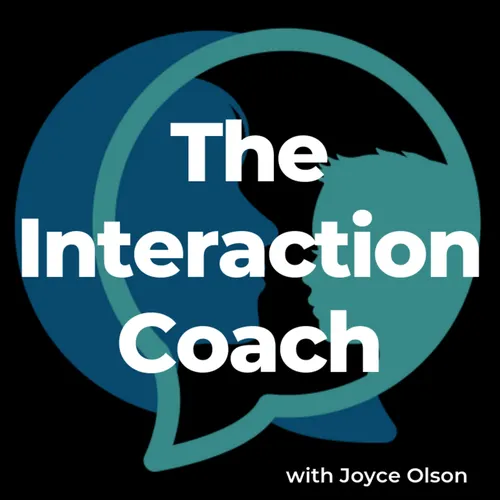
The Interaction Coach
You can help your child learn to talk with speech-language pathologist Joyce Olson of The Interaction Coach. Listen to daily tips that make every interaction a learning opportunity for speech and language development. Whether your child needs to start using words, make longer sentences, or improve social communication, this podcast is for you.
- Update frequency
- every day
- Average duration
- 6 minutes
- Episodes
- 234
- Years Active
- 2019 - 2020

3.114 LITERACY: Writing: Develop new grasp
A speech-language pathologist should be involved with your child’s program if there is a gap in development between some of the domains (for example, language or social interaction is not developing …

3.113 LITERACY: Reading: Use a touch-and-feel book
Young children learn through their actions with objects. Books that incorporate textures with pictures help your child expand their understanding of the pictured object.
Today’s activity: Use a touch…

3.112 LITERACY: Reading: Learn to turn pages
Your child learns how to handle a book from your examples and shaping their responses.
Today’s activity: Help your child turn pages by putting your finger under the next page to make it easier for yo…

3.111 LITERACY: Reading: Wait for a response
Reading a book together can be like a conversation. You are both looking at and commenting on the same thing.
Don’t dominate the “conversation.” Give your child a chance to do or say something after …

3.110 LITERACY: Reading: Follow your child’s lead
At Level Three your child can explore books on their own, turning pages and looking at pictures. They can spend several minutes looking at a book together with you.
Gradually extend the amount of tim…

3.109 LANGUAGE: Use Speech: Use varied intonation
Your child is noticing the changes in meaning that can be expressed with your voice—intonation, loudness, speed, pitch.
Today’s activity: Play with your voice as part of vocal play. Add variety to yo…

3.108 LANGUAGE: Use Speech: Use voice to call for you
Your child’s use of voice to call for you is shaped by your response. They learn to use a louder voice if you are out of sight.
They also learn they can control your action by using their voice—an im…

3.107 LANGUAGE: Use Speech: Have a conversation with vocal play
Skills that develop at Level Three include responding to sounds by making a sound back, using their voice to get attention, babble the same syllable, babble varied syllables, and copy your intonation…

3.106 LANGUAGE: Make Meaning: “Help”
Your child will use some meaningful gestures before they start to use words.
At Level Three you interpret your child’s action as if it has meaning, and then you tell the child the word you think they…

3.105 LANGUAGE: Making Meaning: Reaching means “I want”
You will develop the habit of responding to your child’s actions as if they have meaning. This is the first step in shaping your child’s use of meaningful gestures.
Over time, your child will learn t…

3.104 LANGUAGE: Understand Words: “No!”
Your child will hesitate or look at you when you say “No!” because of your tone of voice.
With more experience, your child will begin to learn that you want them to stop what they are doing.
Get in t…

3.103 LANGUAGE: Understand Words: "Where’s it hiding?"
Your child is learning that the word where means we have to look for it.
Today’s activity: When your child is looking at something, cover most of it or put it in a container and ask, “Where’s the bal…

3.102 LANGUAGE: Understand Words: Where’s the milk?
Today we expand upon your activity of partially covering an object and asking, “Where’s the toy?” with your hands raised and looking around.
In the past you covered something the child was already lo…

3.101 LANGUAGE: Understand Words: ABA or speech therapy?
A question from Anne in New Jersey: My child is getting ABA therapy. Does he need speech therapy from a speech-language pathologist?
Joyce’s opinion: SLPs are trained to understand all aspects of com…

3.100 PLAY: Movement: Up and down
Independent movement helps your child become an independent learner.
Help your child learn all kinds of words (not just the names of things). Say a verb to describe the action that is happening, like…

3.099 PLAY: Movement: Stretch for a toy
At Level Three your child learns to sit with some support, and use their arms to pull or push themselves on their tummy. Movement helps your child be independent in learning more about their world.
B…

3.098 PLAY: Object Use: Make a toy go
Play helps your child develop thinking skills they need for using language.
Today’s activity helps your child learn about cause-and-effect relationships. It also helps your child recognize they can g…

3.097 PLAY: Object Use: Help pick up
Think ahead to things you want your child to do in the future. Model those activities now, to help your child get into the routine. You will be doing the activity. Your child can watch or participate…

3.096 PLAY: Object Use: Hide toy in box
Object permanence is the concept that things exist even when we can’t see them. Your child is starting to understand this idea when things are partially hidden.
Seeing something covered up and immedi…

3.095 PLAY: Object Use: Pull string on a toy
Your child is learning about using a tool to accomplish a goal. (Down the road, they will use words for the same reason.)
Other animals use tools, too. The difference between other animals and humans…